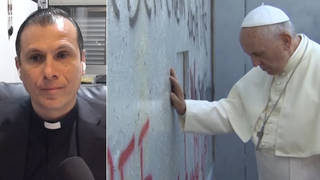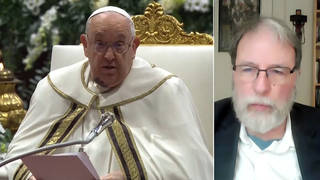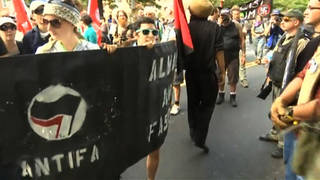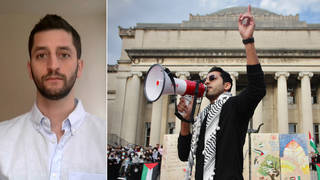
President Trump is facing widespread criticism for his latest comments on the deadly white supremacist protest in Charlottesville, Virginia. Speaking at Trump Tower on Tuesday, Trump said the violence was in part caused by what he called the “alt-left.” President Trump’s comment were widely decried. Former Republican presidential nominee Mitt Romney wrote on Twitter, “No, not the same. One side is racist, bigoted, Nazi. The other opposes racism and bigotry. Morally different universes.” We look at one of the groups who confronted the white supremacists in the streets: the anti-fascists known as antifa. We speak to Mark Bray, author of the new book, “Antifa: The Anti-Fascist Handbook.”
Transcript
AMY GOODMAN: This is Democracy Now!, democracynow.org, The War and Peace Report. I’m Amy Goodman, with Juan González.
JUAN GONZÁLEZ: President Trump is facing widespread criticism for his latest comments on the deadly white supremacist protest in Charlottesville, Virginia. Speaking at Trump Tower Tuesday, Trump said the violence was in part caused by what he called the “alt-left.”
PRESIDENT DONALD TRUMP: OK, what about the “alt-left” that came charging at—excuse me. What about the “alt-left”? They came charging at the, as you say, the “alt-right”? Do they have any semblance of guilt? What—let me ask you this: What about the fact they came charging—that they came charging with clubs in their hands, swinging clubs? Do they have any problem? I think they do. So, you know, as far as I’m concerned, that was a horrible, horrible day. Wait a minute, I’m not finished. I’m not finished, fake news. That was a horrible day.
REPORTER: Mr. President, are you putting what you’re calling the “alt-left” and white supremacists on the same moral plane?
PRESIDENT DONALD TRUMP: I’m not putting anybody on a moral plane. What I’m saying is this: You had a group on one side, and you had a group on the other, and they came at each other with clubs, and it was vicious, and it was horrible, and it was a horrible thing to watch. But there is another side. There was a group on this side—you can call them the left, you’ve just called them the left—that came violently attacking the other group. So you can say what you want, but that’s the way it is.
AMY GOODMAN: President Trump’s comments were widely decried. Former Republican presidential nominee Mitt Romney tweeted, “No, not the same. One side is racist, bigoted, Nazi. The other opposes racism and bigotry. Morally different universes,” unquote. Earlier this week, Cornel West appeared on Democracy Now!. He painted a very different picture of Charlottesville than President Trump, saying anarchists and anti-fascists saved his life.
CORNEL WEST: Absolutely. You had a number of the courageous students, of all colors, at the University of Virginia who were protesting against the neofascists themselves. The neofascists had their own ammunition. And this is very important to keep in mind, because the police, for the most part, pulled back. The next day, for example, those 20 of us who were standing, many of them clergy, we would have been crushed like cockroaches if it were not for the anarchists and the anti-fascists who approached, over 300, 350 anti-fascists. We just had 20. And we’re singing “This Little light of Mine,” you know what I mean? So that the—
AMY GOODMAN: “Antifa” meaning anti-fascist.
CORNEL WEST: The anti-fascists, and then, crucial, the anarchists, because they saved our lives, actually. We would have been completely crushed, and I’ll never forget that.
AMY GOODMAN: To look more at the anti-fascist movement, known as antifa, we’re joined by Mark Bray, lecturer at Dartmouth College. His new book, Antifa: The Anti-Fascist Handbook.
First, pronounce it for us, Mark, and then talk about antifa.
MARK BRAY: Yes, well, it’s pronounced on’-tee-fah. The emphasis is on the first syllable, and it’s pronounced more on than an, so on’-tee-fah. It’s commonly mispronounced. But antifa, of course, is short for anti-fascist.
And, you know, President Trump’s comments that the alt—quote-unquote, “alt-left” and “alt-right” are equivalent moral forces is really historically misinformed and morally bankrupt. The anti-fascist movement has a global history that stretches back over—about a century. You can trace them to Italian opposition to Mussolini’s Blackshirts, German opposition to Hitler’s Brownshirts, anti-fascists from around the world who had traveled to Spain to fight in the Spanish Civil War. More recently, modern antifa can largely trace its roots to the anti-fascist movement in Britain in the ’70s, and the postwar period more generally, that was responding to a xenophobic backlash against predominantly Caribbean and South Asian migration, also to the German autonomous movement of the ’80s, which, really, after the fall of the Berlin Wall, had to respond to a really unprecedented neo-Nazi wave—unprecedented in the postwar period, of course.
And then, in the United States, we can look at anti-racist action in the 1980s, 1990s and the early 2000s, which took some of these methods of confronting neo-Nazis and fascists wherever they assemble, shutting down their organizing and, as they said, going where they go. Today, in an article I wrote for The Washington Post called “Who are the antifa?” I explain this and show how today’s antifa in the United States are really picking up the tradition where these groups left off. And their movement has really accelerated with the unfortunate ascendance of the “alt-right” following President Trump.
The other minor note I want to make before we continue is that antifa is really only one faction of a larger movement against white supremacy that dates back centuries and includes a whole number—there are a whole number of groups that fight against similar foes, sometimes using the same methods, that aren’t necessarily anti-fascists. So, it’s important not to subsume the entire anti-racist movement within this sort of one category.
JUAN GONZÁLEZ: And, Mark Bray, in your book—and I want to quote a few lines from it—you say, “Most people have an 'all-or-nothing' understanding of fascism that prevents them from taking fascists seriously until they seize power. … Very few really believe that there is any serious chance of a fascistic regime ever materializing in America.” And I’m wondering about that and the importance of understanding that concept of yours, for those who are looking at what’s happening today in America.
MARK BRAY: Right. So, the way people understand fascism, or the way they’ve been taught about it, is generally exclusively in terms of regimes. So, the thought goes, as long as we have parliamentary government, we’re safe. But we can look back to the historical examples of Italy and Germany and see that, unfortunately, parliamentary government was insufficient to prevent the stop—to prevent the rise of fascism and Nazism, and actually provided a red carpet to their advance. So, because of that reason, people think of fascism in terms of all or nothing, regime or nothing.
But we can see in Charlottesville that any amount of neo-Nazi organizing, any amount of a fascist presence, is potentially fatal. And, unfortunately, Heather Heyer paid the price for that. So that’s partly why anti-fascists argue that fascism must be nipped in the bud from the beginning, that any kind of organizing needs to be confronted and responded to. Even if, you know, people are spending most of their time on Twitter making jokes, it’s still very serious and needs to be confronted.
AMY GOODMAN: Can you—can you talk about—I mean, very interesting, during the South Carolina protests against the white supremacists, there were flags of Republicans in Spain fighting Franco.
MARK BRAY: Right. So, one of the most iconic moments in anti-fascist history is the Spanish Civil War, and, from an international perspective, the role of the International Brigades, brave anti-fascists who came from dozens of countries around the world to stand up to Franco’s forces. Franco had the institutional support of Nazi Germany and Mussolini’s Italy, whereas the Republican side really only had support of the Soviet Union, which, as I discuss in my book, had a lot of problematic aspects to it. So, if we look at the role of the International Brigades, we can see that anti-fascists view their struggle as transnational and transhistorical. And so, today, if you go to an anti-fascist demonstration in Spain, for example, the flag of the International Brigades, the flag of the Spanish Republic is ubiquitous. And these symbols, even the double flags of anti-fascism that people will frequently see at demonstrations, often one being red, one being black, was originally developed as a German symbol, which, in its earliest incarnation, dates back to the 1930s. So, it’s important to look at antifa not just as sort of a random thought experiment that some crazy kids came up with to respond to the far right, but rather a tradition that dates back a century.
JUAN GONZÁLEZ: You also talk, in your examples, of other countries, not only the period of the 1930s and ’40s, but more recent periods, in England in the ’80s, and in Greece, as well, even more recently, and the importance of direct action by anti-fascists to nip in the bud or to beat back the rise of fascist movements.
MARK BRAY: Right. So, part of what I try to do with my book, Antifa, is draw certain historical lessons from the early period of anti-fascist struggle that can be applied to the struggle today. One of them is that it doesn’t take a lot of organized fascists to sometimes develop a really powerful movement. We can see that recently with the rise of Golden Dawn, the fascist party in Greece, which, prior to the financial crisis, was really a tiny micro-party and considered a joke by most. Subsequently, they became a major party in Greek politics and a major threat, a violent, deadly threat, to migrants and leftists and people of all stripes across Greek society. This was also true back in the early part of the 20th century, when Mussolini’s initial fascist nucleus was a hundred people. When Hiller first attended his first meeting of the German Workers’ Party, which he later transformed into the Nazi Party, they had 54 members. So, we need to see that there’s always a potential for small movements to become large.
And one of the other lessons of the beginning of the 20th century is that people did not take fascism and Nazism seriously until it was too late. That mistake will never be made again by anti-fascists, who will recognize that any manifestation of these politics is dangerous and needs to be confronted as if it could be the nucleus of some sort of deadly movement or regime of the future.
AMY GOODMAN: I wanted you to talk, Mark Bray, about the presence of Stephen Bannon and Sebastian Gorka and Stephen Miller in the White House and what that means to antifa, to the anti-fascist movement.
MARK BRAY: Right. Well, the other side of it is it’s not just about how many people are part of fascist or neo-Nazi groups. It’s also about the fact that far-right politics have the ability to infiltrate and influence and direct mainstream politics. And we can see that with the “alt-right.” The “alt-right” is not really actually a lot of people in terms of numbers, but they’ve had a disproportionate influence on the Trump administration and certain aspects of public discourse. So, the presence of Bannon and Gorka and Miller in the White House really just gives some sort of a hint as to why it is that Trump yesterday basically said there are good people on both sides of this conflict, that Friday night, when there were neo-Nazis wielding torches in Nazi style and they attacked nonviolent UVA student protesters, that he said, “Oh, well, you know, these are good people.”
So, part of it is the organized street presence, but, as we saw, by confronting the organized street presence in Charlottesville, this created the question of just how bad these people are, because—you played earlier, Mitt Romney condemned the fact that there could be blame ascribed to both sides. Well, prior to Charlottesville, that was the dominant media narrative. Most mainstream media was saying, “Oh, well, we have, quote-unquote, 'violence' on both sides. Hands up. Who’s to say who’s right or wrong?” But by confronting this, by putting it in the spotlight, by shining a light on what these people really think, it’s shifted the public discourse and pushed back the ability of some of these “alt-right” figures to try and cloak their fascism.
JUAN GONZÁLEZ: And what do you say, for instance, to those who maybe are opposed to the viewpoints of the white nationalists and white supremacists, but also attempt to condemn any attempts to shut them—shut them down or not allow them to speak? Or—and, obviously, the American Civil Liberties Union fought for the right of the Charlottesville—the white nationalists to have their rally in Charlottesville.
MARK BRAY: Right. Well, the question of how to combat fascism, I think, always needs to come back to discussions of the 1930s and 1940s. So, clearly, we can see that rational discourse and debate was insufficient. Clearly, we can see that the mechanisms of parliamentary government were insufficient. We need to be able to come up with a way to say, “How can we make sure never again?” By any means necessary, this can never happen again. And the people back there who witnessed these atrocities committed themselves to that.
So the question is: OK, if you don’t think that it’s appropriate to physically confront and to stand in front of neo-Nazis who are trying to organize for another genocide now, do you do it after someone has died, as they just did? Do you do it after a dozen people have died? Do you do it once they’re at the footsteps of power? At what point? At what point do you say, “Enough is enough,” and give up on the liberal notion that what we need to do is essentially create some sort of a regime of rights that allow neo-Nazis and their victims to coexist, quote-unquote, “peacefully,” and recognize that the neo-Nazis don’t want that and that also the anti-fascists are right in not looking at it through that liberal lens, but rather seeing fascism not as an opinion that needs to be responded to respectfully, but as an enemy to humanity that needs to be stopped by any means necessary?
AMY GOODMAN: This is Part 1 of our conversation, Mark Bray. We’ll do Part 2 and post it online at democracynow.org. Mark Bray is the author of a book that is coming out in the next few weeks called Antifa: The Anti-Fascist Handbook. He is a lecturer at Dartmouth College.













Media Options